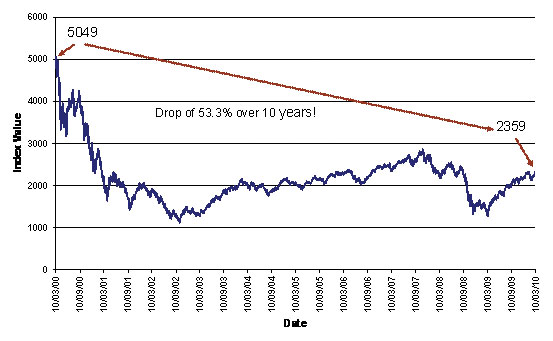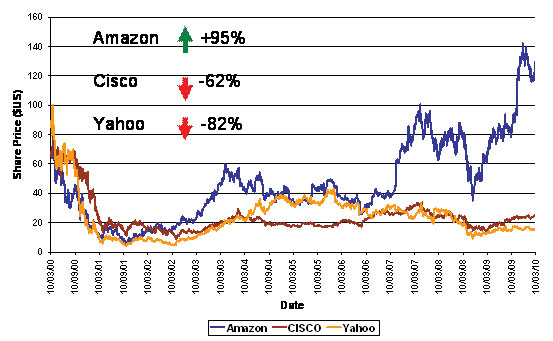One of the great pleasures of a regular column is the numerous reader interactions via email. Questions about investing in the tourism and leisure sector via shares seem to be top of mind for many. With the war over the story goes, there will be a boom in tourism, and thus profits are to be had in the sector. Many are contemplating how best to tap this perceived eternal source of wealth. Before committing all your life savings to this seemingly wonderful idea, contemplate the plight of people who thought the same of Internet stocks in the late nineties.

Kajanga Kulatunga |
March 10, 2010 marked 10 years since the investment craze in technology and telecommunications companies ended. On March 10, 2000, the barometer of dotcom mania – or what was the technology and telecom bull market of the 1990s – the Nasdaq Composite, closed at a high of 5,048.62.
That completed the Nasdaq’s stunning rise from a level of just 750 at the start of 1995, a gain of 573 %. Once it started to crash, it did not stop until it hit 1,114.11 in October 2002 – a drop of almost 80 % from its peak. Ten years to the day since its high, the Nasdaq sat at 2,359, some 53.3 % below its greatest moment.
The insanity of this bubble was comparable with any in history. The continuing lesson though was that investors always buy on the rumour and sell on the news, when doing the opposite is the more prudent way to make money. It's tempting, but wrong, to wite off the tech mania as mass insanity by the ignorant and ill-informed. In March 2000, a survey of chief financial officers by Duke University found that 82% of these sophisticated insiders felt that their stock was underpriced, 15% thought it correctly priced and only 3% overpriced.None of this meant that all tech companies turned out to be a bad investment.
oogle, arguably the single biggest winner from the Internet, did not even go public until four years after the bubble burst. Shares in Amazon, by far the most successful Internet retailer, hit an all-time high of $US 142 in December 2009, well above their dotcom period peak of $US 89. Technology has also been one of the strongest performers of the last 12 months. It has not lost its allure 10 years later. Counting out specific technology companies and sectors, such as bio-technology on the basis of the previous bubble, would be unwise.
Most of the consensus favourites among tech stocks turned out to be investing disasters. But in an odd way, the Internet bubble has left all of us better off, as its benefits have percolated throughout the economy and produced huge productivity gains across all sectors. The bubble helped create the global communications backbone for the current generation of more successful internet services (e.g. YouTube, Facebook).
These developments have also lead to many employment opportunities in various Internet based industries in Sri Lanka. Various opportunities from BPOs to domestic technology firms would not be in existence had it not been for some of the excesses during he tech bubble.
Like most bubbles, the tech mania was rational and foolish at the same time. Investors foresaw a market opportunity that would be explosively profitable. Then, having no sure way to know who the ultimate winners would be, they bid up every company having anything to do with that opportunity.
The Internet did change business forever, just as investors had predicted. And a handful of technology companies did strike it rich. But by far the biggest beneficiaries of the Internet boom were the companies that adopted the new technology rather than those that provided it.
Diversification may be boring and hard to defend in rising markets, and harder still in extreme falling markets, but remains the investors’ best friend. Diversification is a risk management strategy as much as a return seeking strategy. Diversification may not work all the time, but it will work over the course of time.
Investors should evaluate the merits of any new investment idea, in terms of both risks and rewards to their life, and whether those opportunities are warranted to help you achieve your goals. Future returns don’t depend on the best investment story, but the price which you pay to access opportunities.
Ten years ago, investors knew that technology would change the world, and they were right. But you can be 100% right about the future and end up with zero to show for it if you overpay in the first place. That was true for technology in the 90’s, it’s true for the tourism sector today and will be true for whatever new shingle which comes your way next.
(This columnist is an Investment Specialist based in Sydney, Australia. He can be contacted via kajangak@gmail.com).

Source: Nasdaq
Figure 1: Nasdaq Composite Price index performance from 10 March 2000 through March 10, 2010. |
| |

Source: Company reports
Figure 2: Share price performance of three major technology companies. Amazon remains the clear winner, while Cisco and Yahoo are well below their 2000 highs. |
|




